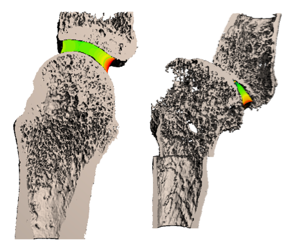Session Information
Session Type: ACR Poster Session C
Session Time: 9:00AM-11:00AM
Background/Purpose: Functional decline and reduced quality of life for patients with rheumatoid arthritis (RA) results from chronic changes to joints in patients, including bone erosions and joint space narrowing. Advanced biologic therapies can prevent joint damage progression, and it has been suggested that they can repair bone damage 1,2. High resolution peripheral quantitative computed tomography (HR-pQCT) provides measurement of joint space and bone microstructure with high sensitivity and precision. The purpose of this study was to investigate whether HR-pQCT can detect joint damage repair in patients initiating biologic therapies, and whether changes in joint damage are associated with changes in clinical outcomes.
Methods: We recruited 88 participants who met the ACR/EULAR 2010 Classification Criteria for RA and were starting on a new biologic agent due to moderate or high disease activity. The 2nd and 3rd MCP joints of the dominant hand were scanned with a HR-pQCT scanner (XtremeCTII, Scanco Medical, 61mm) at 3 and 12 months after initiating the new agent. Participants also underwent a rheumatologist examination for disease activity and self-reported measures of physical (Health Assessment Questionnaire) and hand (DASH Questionnaire) function were collected at these visits, along with the Jebsen hand function test. Joint space volume (JSV) was measured in 3D using an algorithm developed by the SPECTRA collaboration3 (Figure 1) . Bone erosion quantification will be completed using a 3D segmentation technique using MIAF-Finger4. Individual changes in JSV were classified as increased or decreased if the absolute changes were greater than detection limits based on least significant change.
Results: The cohort was 72.7% female with an average disease activity score (DAS28) of 2.58 at baseline and 2.60 at 9 month follow-up. The average DASH score was decreased to 27.6 from 29.3, while the average HAQ score increased to 0.89 from 0.86. There were no statistically significant changes in clinical results. When compared to detection limits, 73 of the 84 analyzable joints showed no change in joint space volume, 5 showed an increase and 6 showed a decrease . We found no significant relationships between joint space outcome and disease activity, physical function, or hand function.
Conclusion: In most patients there were no significant changes in joint space as they initiate or change biologic therapies. This may be due to a large detection limit making it difficult to detect changes over a 9 month period. Future erosion analysis will provide further insight on the potential benefits of biologic therapy with regards to the reversibility of bone damage as seen on HR-pQCT.
1. Van Der Heijde D. Ann Rheum Dis. 2011. 2. Schett G, et al. Arthritis Res Ther. 2011. 3. Stok KS, et al.Osteoarthr Cartil. 2017.4. Töpfer D, et al. Rheumatol (United Kingdom). 2014.
Figure 1. 3D visualizations of joints with a large JSV (left) and a small JSV (right).
To cite this abstract in AMA style:
Brunet S, Manske S, Engelke K, Boyd SK, Barnabe C. Joint Repair While Initiating Biologic Therapy in Rheumatoid Arthritis [abstract]. Arthritis Rheumatol. 2018; 70 (suppl 9). https://acrabstracts.org/abstract/joint-repair-while-initiating-biologic-therapy-in-rheumatoid-arthritis/. Accessed .« Back to 2018 ACR/ARHP Annual Meeting
ACR Meeting Abstracts - https://acrabstracts.org/abstract/joint-repair-while-initiating-biologic-therapy-in-rheumatoid-arthritis/

